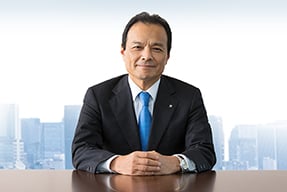Described below is the summary of Q&A session with institutional investors and securities analysts at the FY2012 3Q results conference call held on February 13, 2013.
- Q1In auto, the number of reported claims in 3Q FY2012 (Oct-Dec 2012) seems to be in a rising trend in comparison with the first half of FY2012. Since you explained that there was no big change in the accident frequency, can we think that this increase resulted from temporary factors such as the heavy snowfall?
- A1
In the first half of FY2011, the number of reported claims increased mainly due to the toll-free expressway program. As a result of its reversal effect, there was a slight decrease in the growth rate of the number of reported claims in the first half of FY2012. On the other hand, in the second half of FY2012 when no such reversal effect existed, the growth rate slightly increased. Consequently, in the cumulative results as of the end of 3Q FY2012 (Apr 1 - Dec 31, 2012), the rate roughly leveled off YoY.
- Q1(2)Are you saying that the impact of the heavy snowfall was not significant?
- A1(2)
Heavy snowfalls were seen also this fiscal year in December and January and are causing a certain level of increase in incurred losses. However, we believe the overall trend of losses is remaining within our original projections, even when factoring in the impact of the heavy snowfall.
- Q2Please let me confirm the sales amount of business-related equities. As far as I understood, excluding redemptions of preferred equity securities which have no impact on sales gains, the cumulative sales amount as of the end of 2Q and 3Q and its full-year projections are roughly 15 billion yen, 47 billion yen, and 74 billion yen respectively. Is my understanding correct?
- A2
Including redemptions of preferred equity securities, the cumulative sales of business-related equities was approx. 31 billion yen in 2Q and approx. 63 billion yen in 3Q, and approx. 90 billion yen is projected in the revised projections for the full year. Subtracting the redemptions, the figures you mentioned roughly correspond with these figures.
- Q2(2)Looking by each quarter, the sales amount planned for 4Q FY2012 is roughly 27 billion yen, which seems to fall slightly below the 3Q results. Should we think that there will be no significant change to the revised projections, even when factoring in the current stock market rise?
- A2(2)
There has been no change in our policy aiming at yearly sales of approx. 100 billion yen during the current three-year mid term plan, though there will be differences among years.
- Q3The combined ratio (private insurance) at TMNF was 97.5% in 3Q, whereas it is 99.5% in the full-year projections. It seems that the ratio will worsen in 4Q. What are the reasons behind the worsening projections? Could the payment relating to Hurricane Sandy be one of them?
- A3
Although we revised TMNF's incurred losses relating to Hurricane Sandy to 20 billion yen (up by 10 billion yen from the previous projection as announced on November 19, 2012), there is no change to the projected amount of net claims paid (10 billion yen). One of the factors for the projected C/R worsening for the full year compared with 3Q is the progress of claims payment relating to other natural catastrophes.
- Q3(2)During the three months of 4Q, how much net claims paid do you expect relating to natural catastrophes?
- A3(2)
As at the end of 3Q, net claims paid relating to Hurricane Sandy was approx. 5 billion yen, and remaining 5 billion yen is to be paid in 4Q. Including losses from other natural catastrophes, net claims to be paid in 4Q, relating to natural catastrophes occurred in FY2012, is estimated to be approx. 10 billion yen. In addition, payment relating to natural catastrophes occurred in the previous fiscal year will also negatively affect W/P loss ratio.
- Q3(3)That means you don't expect any additional negative factors worsening auto loss ratio toward the end of this fiscal year. Is my understanding correct?
- A3(3)
Yes, it is. We assume that the trend in auto loss ratio will remain unchanged in 4Q FY2012 (Jan-Mar 2013) compared to the situation as of 3Q FY2012 (Apr-Dec 2012). Based on this assumption, no additional negative factor is expected at this moment.
- Q4International insurance business seems to have achieved a remarkable growth as a result of the favorable top-line growth at each segment, including reinsurance and Asian businesses even when the positive FX effect is excluded. To my understanding, international insurance business sets an aggressive top-line growth target for FY2014. How do you evaluate the current progress toward the target?
- A4
The FY2014 target growth of international insurance business consists of revenue growth of approx. 200 billion yen YoY owing to its organic growth, and the effect of P/L consolidation of Delphi. We consider the progress as of the end of 3Q is on track with the mid-term business plan. We will keep a close eye on its progress aiming at growth with profitability without becoming over top-line-centric.
- Q5Concerning the upward revision of ordinary profit announced today, the change in international insurance business was 12.8 billion yen, accounting for more than half of the total change of 25 billion yen. The improvement seems to be significant even when considering the positive effect of the depreciation of the yen. Which businesses are doing well? Also, please explain whether or not these positive factors are to remain in the future.
- A5
The main factors for the upward revision of ordinary profit from international insurance business are as follows:
i) An expected increase of incurred losses by 2 billion yen relating to Hurricane Sandy
ii) Positive effects of the depreciation of the yen
iii) Favorable performance up until the end of 3Q FY2012
Also, we perceive the current market condition for the U.S. and other businesses to be on a recovery trend. - Q6Concerning auto, what level of E/I loss ratio do you expect at the end of FY2012, excluding effects of natural catastrophes? If the trends in accident frequency and unit claims cost do not change, can we expect a YoY improvement also at the fiscal-year end, as in 3Q FY2012?
- A6
The basic trend in unit claims cost is on track with our plan. Therefore, some improvement is expected also at the fiscal-year end.
- Q6(2)This fiscal year, temporary increase in loss adjustment expenses is recognized. Do you still expect the said improvement even when including this impact?
- A6(2)
Yes, we do.
- Q7The revised projections are based on FX rate and stock prices as of the end of December, but the depreciation of the yen and stock market rise have further progressed since then. I assume that the depreciation of the yen has a negative effect on the results, but this could be offset by the positive effect of the higher stock prices. Could you give me any comment on its impact to your business based on these trends?
- A7
As we have explained, the depreciation of the yen has a negative effect on the Group's P/L. The latest sensitivity is as follows:
In the event of a one-yen depreciation, the Group's P/L will:
i) Increase in provision for foreign currency-dominated outstanding claims reserves
(-2 billion yen, pre-tax) at TMNF,
ii) Decrease in gains on derivatives (foreign exchange forwards, etc.)
(-0.7 billion yen, pre-tax) at TMNF,
iii) Increase in profit of overseas subsidiaries (through conversion into yen)
(Approx. +1 billion yen in consolidated results, after-tax) at Overseas subsidiaries.
The latest exchange rate of 93 yen to the US dollar is lower by 7 yen than that of the end of December. Based on this FX rate, there would be negative impact on TMNF by approx. ten and some billion yen (multiply -2.7 billion yen by 7). Please note that the FY2012 results of overseas subsidiaries will not be affected by the further depreciation of the yen after January 2013, since the results have been finalized using the rate as of the end of December 2012.
On the other hand, we expect increase in gains on sales of securities and decrease in impairment losses on securities due to higher stock prices, +10% compared to the end of December. In addition, the improved market conditions are expected to reduce the provision for additional underwriting reserves at FL. Considering these factors, we expect that the negative effect of the depreciation of the yen will be considerably offset by the rise in stock prices. - Q8TMNF's projections on its expense ratio for the full year were revised downward by 0.3 points from the previous projections announced in November 2012. According to your account, the main reason for this revision was the continuous reduction in non-personnel expenses. Can we expect further reduction in and after FY2013?
- A8
The amount of reduction in business expenses reflected in our revised projections was approx. 6 billion yen. This was not achieved by carrying forward this year's expenses into the next year, but by our efforts for cost reduction. Therefore, it will not be a factor for increasing cost in FY2013.
- Q9Based on the stock prices as at the end of December, what is the current level of ESR? Could you provide information on its sensitivity along with any other information available?
- A9
ESR is disclosed only at the end of 2Q and 4Q. Its sensitivity is ±4% against ±1,000 yen fluctuation of the Nikkei Average.
- Q10How do the factors for 3Q revisions affect your adjusted earnings?
- A10
As explained earlier, in international insurance business, there was an upward revision by 3 billion yen. At TMNF, there were positive factors such as increase in gains on sales of business-related equities and decrease in impairment losses on securities resulting in an upward revision of its full-year projections on financial accounting basis. However, these are factors that are not reflected to adjusted earnings. Therefore, adjusted earnings are affected mainly by the following negative factors associated with the depreciation of the yen: i) increase in provision for foreign-currency-denominated outstanding claims reserves and ii) decrease in gains on derivatives. FL will be positively affected by the improvement of the financial market conditions.
- Q11Responding to the improvement of the stock market, are there any changes in your policy on return to shareholders, namely on your dividends and share repurchase plan?
- A11
There is no change to our policy on return to shareholders. The primary means of shareholder returns is dividends, while we conduct share repurchases in a flexible manner. Dividends are projected to increase by 10% YoY as we announced at the beginning of the year.
These information materials are prepared based on the currently available information for us and described subject to our predictions and forecasts carried out at the time of preparation.
It must be noted that what is described therein does not guarantee our future business performance and carries certain risk of misjudgment or uncertainty.
Accordingly, you are kindly requested to bear in mind that there may be a possibility of sizable divergence between the actual business performance in the future and that of our predictions or forecasts described therein.Recommended Contents





